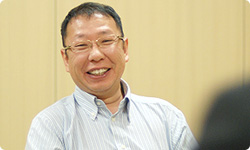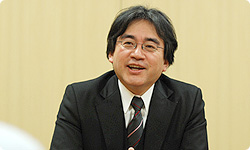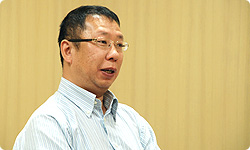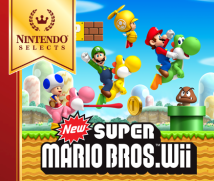2. I’d Never Heard Of Pac-Man
Now at this point, I’d like to turn to you, Tezuka-san.
Go ahead.
What did you work on after you joined Nintendo?
Actually, the year I joined, I was initially asked to work on a small job on a part-time basis.
This is before you joined the company full-time?
Right.
Was the company particularly busy at the time?
I suppose they just wanted to give me a trial run.
They wanted to find out what you were really like! (laughs)
Right. I guess they were a little nervous. (laughs) When I was working at the company part-time, Super-Punch Out!! 13 was in the works and I helped out with some of the pixellated images. 13 Super Punch-Out!! was the sequel to Punch-Out!! and was released in the arcades in 1985.
So you were working even though you were still a student at the time?
That’s right.
But students on an art course would have had their final project to work on. Weren’t you really busy in the run up to your graduation?
I was just about to graduate, so I had plenty of free time.
I see.
But I really only worked in that part-time position for a little while, just for a period of a few weeks. That was my first job at Nintendo.
What was your first impression when you met Miyamoto-san?
Well, I…
You don’t remember?
Right. I don’t really remember! (laughs)

That’s just like you, Tezuka-san! (laughs)
(laughs)
So even though Nakago-san worked on porting Donkey Kong to the Famicom, he claimed he didn’t have a clue who Miyamoto-san was. Now, although it should have been some kind of date with destiny, you can’t remember anything about first meeting Miyamoto-san. Yet from those inauspicious beginnings, you've worked together as a three-man team for the last twenty-five years! It really is a funny old world! (laughs)
I belonged to the Creative Department at the time…
Was Miyamoto-san assistant manager at that point, or was this before he was promoted?
It was before he was promoted. So he was my senior in terms of experience at the company, but not in terms of position. Now there were only a few people in that department…
That was a time when there were very few designers on the staff. This meant that graduates from an art background would tend to be gathered in that department, and then depending on the demand for designers from across the company, they would try to adapt and meet those needs.
That’s right. So we did all kinds of things such as working on instruction manuals and designing playing cards…
You’d also design the images on arcade cabinets. If anyone needed anything designed, it was your department that they’d call.
Right.
Why did you originally apply to work at Nintendo?
I wouldn't have described myself as being a particularly big fan of video games, but I did have a lot of interest in jobs related to leisure and recreation. For instance, I was interested in getting involved in designing goods branded with characters’ images. Students who’d studied design at university would often go on to work for printing companies or advertising agencies. But I wasn’t particularly interested in the kind of jobs where you would first get a client, then design things in line with their requirements…
You wanted to make things for yourself.
That’s right. I felt really strongly about that.
How were you introduced to Nintendo?
A friend of mine at the time had applied to work for Nintendo and he’d told me that it seemed like an interesting company.
So if it hadn’t been for that friend, you wouldn’t be sitting here today?
I wouldn’t be here today! But that friend didn’t manage to graduate, so he didn’t end up joining Nintendo.
Life is strange, isn’t it? If it hadn’t been for that coincidence, Miyamoto-san wouldn’t have gained his closest ally.

(laughs)
So after joining Nintendo, what was the first job you worked on alongside Miyamoto-san?
When I was here part-time, I worked on Super Punch-Out!! Then once I joined the company full-time, the first job I did was... What was it again? Oh, that's right! It was Devil World 14. It was a dot-eating game15. 14 Devil World was an action game released for the Famicom in October 1984. 15 Dot-eating games were games where the player attempted to avoid enemies in a maze while manoeuvring over dots in order to increase their score.
It was a game along the lines of Pac-Man16. 16 Pac-Man was an arcade game released in 1980 by Namco (now Namco Bandai Games Inc.). A huge hit worldwide, it later appeared on the Nintendo Entertainment System.
Right. But at that time, I hadn't heard of Pac-Man…
Wait! Hang on just a second! Are you telling me that someone who joined Nintendo in order to make video games and who is currently the head of the Software Development Department entered the company in 1984 without knowing Pac-Man?
I'd never heard of it! (laughs)
That’s unbelievable! (laughs)
(laughter)
Do you find that shocking?
No, I’m just a little taken aback, that's all! (laughs)
Then when I played Pac-Man for the first time, I just thought: “Well, this is a fun game!”
(laughs)
At the time, my job was to create pixellated images. Usually, I’d be given very rough and ready instructions…
So you’d be told: “Just draw something. It doesn't matter what!"
Right. But because Miyamoto-san had a strong basic idea of the image he was after, he'd give me fairly detailed instructions: "Make it this shape. And it should be this size.”
At that time the hardware imposed severe limitations, so if you didn’t have a clearly defined image of what you wanted, it would often end in failure.
That’s right. In a sense, having to create something within the bounds of those limitations was actually a really enjoyable job.
It was a bit like trying to solve a puzzle.
Yes, it was. What’s more, the company at that time didn’t have dedicated game designers who would come up with ideas for games...
In the period we're discussing, the position of full-time dedicated game designer didn’t yet exist, so the people designing the graphics or doing the programming would come up with ideas.

That’s right. At that time, everyone put their heads together, collected their ideas and made the games in an amateur spirit. So I would also come up with ideas…
What kind of ideas did you come up with?
For instance, when I was working on Devil World, there were roller bars on the left and right of the screen which would scroll...
Then if you got pinned between those bars and the wall of the maze, it was all over.
That’s right. Anyway, I suggested that we should have holes and you’d lose the turn if you fell into them. So we actually made a version to test it out.
From around that time, Nintendo developers were starting to make games in a way where they could actually make a version in order to test ideas out. And when you tried it out, how did it go?
I was told: “This is a bit flat.” So we went back to the original feature of being pinned by the roller bars.
So your idea wasn’t used in the end.
Right! I was really disappointed! (laughs)
